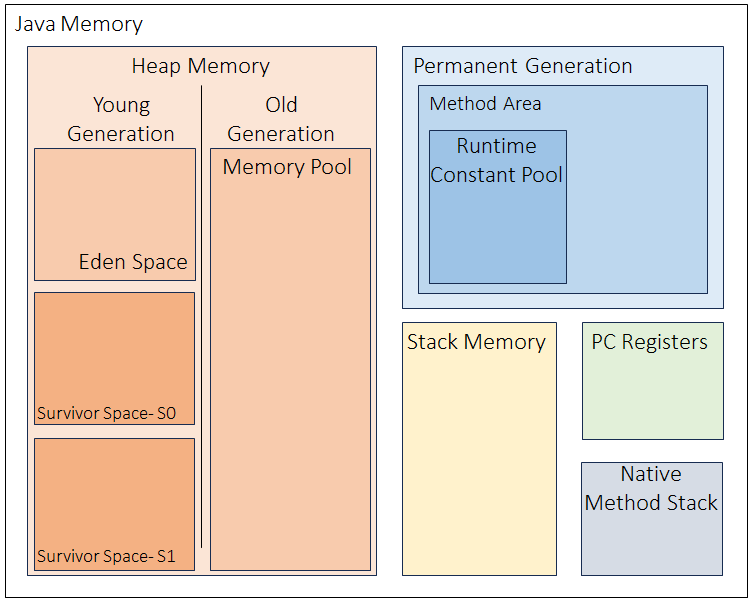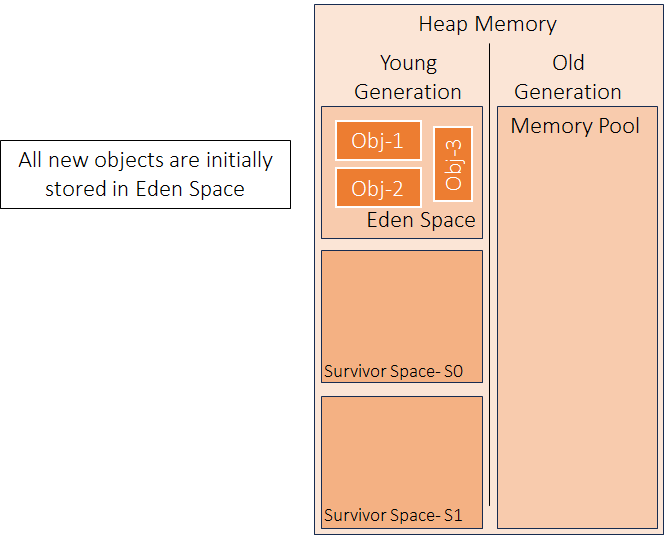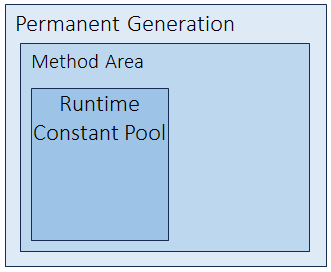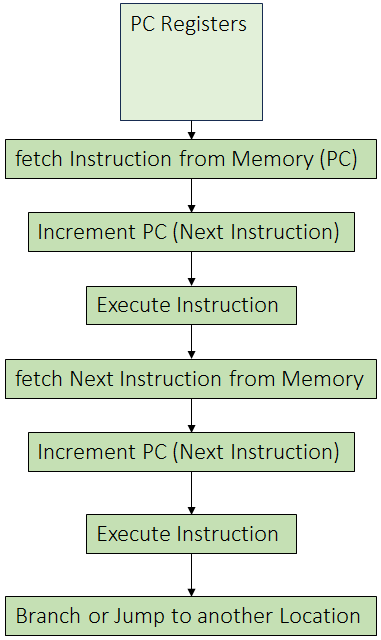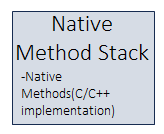Java Memory management in Java refers to the process of handling computer memory (RAM) effectively and efficiently to store and manage objects created during the execution of a Java program. It involves allocating memory to new objects when they are created and freeing up memory from objects that are no longer needed (garbage collection) to make room for new objects.
In other words, memory management in Java ensures that the program uses memory wisely by creating and destroying objects as needed, preventing memory leaks and excessive memory usage, and allowing the Java Virtual Machine (JVM) to optimize memory usage automatically, so developers don’t have to worry about manually managing memory. This automated process makes Java a more developer-friendly language when compared to languages that require manual memory allocation and de-allocation.
Java Memory Management & Model
Java memory has many different components. Below, we have a complete picture of how memory is organized in Java.
Let’s understand each component of the Java memory in detail:
Heap Memory
- The Java heap is the runtime data area in the Java Virtual Machine (JVM) where objects are allocated.
- It is shared among all threads in the application.
- The heap is divided into different regions, such as the Young Generation and the Old Generation, each serving different purposes.
- The garbage collector manages the heap to reclaim memory from objects that are no longer in use.
Young Generation
- The Young Generation is the part of the heap where new objects are initially allocated.
- It is further divided into the Eden Space and two Survivor Spaces (often referred to as “from” and “to” spaces).
- Newly created objects are allocated in the Eden Space.
- If Eden Space becomes full, garbage collection (Minor GC) is performed, objects that are not in use and pointing to null get removed.
- During garbage collection in the Young Generation, objects that are still in use are moved to one of the Survivor Spaces.
- The Survivor Spaces are used alternately to identify objects that survive multiple garbage collection cycles.
Eden Space
- The Eden Space is a sub-region of the Young Generation where new objects are allocated.
- It is the initial allocation area for most objects.
- When the Eden Space becomes full, a Young Generation garbage collection is triggered.
Survivor Space
- Survivor Spaces are two sub-regions in the Young Generation, often referred to as “from” and “to” spaces.
- Objects that survive a garbage collection pass in the Young Generation are moved from the Eden Space to one of the Survivor Spaces.
- During the next garbage collection cycle, the surviving objects are copied from one Survivor Space to the other in a back-and-forth manner.
- The primary goal of the Survivor Spaces is to identify long-lived objects that should be promoted to the Old Generation.
Old Generation
- Also known as the Tenured Generation, the Old Generation is the part of the heap where long-lived objects are stored.
- Objects that are deemed stable and long-lived are moved from the Young Generation to the Old Generation.
- Garbage collection in the Old Generation occurs less frequently compared to the Young Generation.
- When the Old Generation in Java’s memory becomes full, the JVM pauses the application, identifies and removes unnecessary objects in a process called “major garbage collection,” and then resumes the application.
Memory Pool
- Memory pools are divisions within the heap memory, used to organize and manage different types of data efficiently.
- They play a crucial role in memory management and garbage collection strategies in the JVM.
- Memory pools include:
- Young Generation: For short-lived objects, undergoes frequent garbage collection (minor GC).
- Old Generation: For long-lived objects, undergoes less frequent garbage collection (major GC).
- Metaspace (or Permanent Generation in older versions): Stores class metadata, runtime constant pool, and interned strings.
- Code Cache: Stores compiled native code generated by the JIT compiler for frequently executed methods.
- Compressed Class Space: Stores compressed class data on 64-bit systems with -XX:+UseCompressedClassPointers.
- The division of heap memory into memory pools helps optimize memory usage and application performance.
Permanent Generation
- PermGen (Permanent Generation) used to be a part of the heap in Java versions before Java 8. It stored class metadata, interned strings, and other reflective information.
- Starting from Java 8, PermGen was replaced by Metaspace. Metaspace is still a part of the heap memory, but it has dynamic sizing and handles class metadata differently.
Method Area
- Stores class metadata, runtime constant pool, bytecode instructions, static variables, and internal references for loaded classes.
- Essential for class loading, method execution, and dynamic class resolution in Java.
- In Java 8 and later, “Permanent Generation” replaced by more efficient “Metaspace” in the native memory area.
Runtime Constant Pool
- Part of Method Area (or Metaspace in Java 8+).
- Stores constants and symbolic references for each loaded Java class.
- Includes string literals, numeric constants, and other constant values.
- Holds symbolic references to other classes, fields, and methods used by the class.
- Supports dynamic method resolution and dynamic class loading.
- Crucial for Java features like virtual method invocation and method overriding (polymorphism).
- Used for bytecode optimization and efficient execution of Java programs.
PC Register
- The Program Counter (PC) Register is a special memory location in each thread that keeps track of the current execution point, the next instruction to be executed.
- Special register in the CPU.
- Keeps track of the memory address of the next instruction to be executed.
- Increments after fetching an instruction.
- Allows sequential execution of instructions.
- Modified during branching or jumping instructions to change execution flow.
- Ensures correct order of operations and effective program execution.
Native Method Stack
- Separate memory region in the JVM.
- Supports execution of native methods (implemented in languages like C or C++).
- Manages flow, local variables, and method calls for native methods.
- Acts as a bridge between Java and native code.
- Ensures isolation from the regular Java stack.
- Allocated and managed by the operating system and JVM.
- Important for proper execution of native methods in Java programs.
Stack Memory
- Region of computer memory for function execution and local variables.
- Follows Last In, First Out (LIFO) principle.
- Handles recursion and separate function calls with stack frames.
- Limited in size, can cause stack overflow with excessive usage.
- Automatic memory management: allocation and deallocation are automatic.
- Fast and efficient memory operations compared to dynamic memory allocation on the heap.
- Each thread has its own stack memory, ensuring thread-specific isolation.
